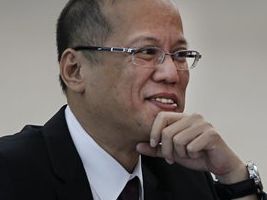Aquino peace drive part of parents’ ‘continuing journey’
President Benigno Aquino’s dogged determination to end the Moro rebellion within his term is part of what Malacañang dubbed as “a continuing journey” started by his parents.
Thus, the signing of the framework agreement between the government and the Moro Islamic Liberation Front (MILF) on Monday took on another dimension as it would clear the way for the President to complete the unfinished business of his parents in Mindanao before his term ends in 2016.
The historical significance of the new accord was not lost on MILF chairman Murad Ebrahim, who acknowledged in his speech at Malacañang the President’s sincerity in finding a peaceful resolution to the 40-year Moro war for independence.
“Today, we are here to put an end to the adversarial relationship between the Bangsamoro people and the Philippine government, and what makes this more significant and quite touching on our part is that this is happening under the administration of President Noynoy Aquino,” Murad said, eliciting applause from the audience gathered at Rizal Hall of Malacañang.
Murad recalled that the President’s assassinated father, Sen. Benigno “Ninoy” Aquino Jr., and mother, the late President Corazon “Cory” Aquino, “fought on the same side of the fence with us against the dictatorship that devastated our homeland and snuffed the lives of thousands of our people.”
Article continues after this advertisement‘Never again’
Article continues after this advertisementBorrowing the ‘never again’ campaign battle cry of Corazon Aquino in the snap elections in 1986, Murad said, “We pray never to see again refugee camps crowded with old folks, women and children wallowing in squalor and misery, as well as never again witness the recurring wholesale violation of human rights that come with oppression, all of which deface the landscape of our Bangsamoro homeland and denigrate the lofty human values long held by a civilized and just society.”
He dedicated the agreement to the late MILF leader Hashim Salamat and other Moro fighters, “whether MILF or MNLF (Moro National Liberation Front), for the cause of Allah and for the Bangsamoro.”
“To them and to all the peace-loving people in this country, this agreement shall stand as our greatest tribute,” he said.
He called on the MNLF faction of Nur Misuari to support the agreement.
“Make this historic journey with us to rebuild our Bangsamoro homeland,” said Murad, after Misuari attacked the new accord as a sell-out.
“This is not the time for recrimination. This is the time for unity, the time for all of us to think, act and speak as one Bangsamoro as we summon all our strength to face the daunting task of home rule,” Murad added.
Family mission
In a statement issued ahead of the signing of the landmark deal, the Office of the Presidential Adviser on the Peace Process (Opapp) noted that finding a lasting solution to the Moro rebellion was the “mission” of the Aquinos.
Opapp called this peace mission “a continuing journey.”
In 1968, the President’s father, Ninoy Aquino, started this journey when he exposed on the Senate floor the “Jabidah Massacre” that claimed the lives of at least 28 Muslim army recruits.
Senator Ninoy had demanded justice for the mass murder of Muslim recruits who had secretly undergone commando training on Corregidor Island.
Quoting unnamed accounts, the Opapp said that the “training was part of a plot by President (Ferdinand) Marcos to infiltrate Sabah (Malaysia), agitate the people there to turn against the government, and demand annexation to the Philippines. When the trainees refused, they were summarily shot.”
That singular event triggered the Moros to press for independence in May of 1968 and eventually take up arms in 1972, the year the MNLF was founded by then University of the Philippines professor Nur Misuari who had vowed to fight for the establishment of a “Bangsamoro Republic.”
Sulu meeting
Barely seven months as President, Corazon Aquino met with Misuari on Sept. 5, 1986, right at the heart of the Moro rebellion in Maimbung, Sulu province.
The unprecedented move softened Misuari’s stance, leading to MNLF’s accession to a ceasefire with the government, and later a peace deal in 1996 with the succeeding Ramos administration.
Seeing parallelism with what the Aquinos did during their time, Opapp noted that Mr. Aquino followed in the footsteps of his parents.
He met Murad on Aug. 4, 2011, in Tokyo, Japan, behind closed doors, breaking protocol just like his mother did 26 years earlier.
In both instances, the mother and later the son displayed the “highest form of confidence-building in the peace process” that can “fast-track the talks to its final conclusion,” said Opapp, quoting Guiamel Alim, a member of the Council of Elders of the Consortium of Bangsamoro Civil Society.
‘Fellow victims’
In his speech Monday, Mr. Aquino admitted that he was criticized for “supposedly demeaning the presidency by meeting with a rebel group.”
But in an explanation that earned the President applause, he recalled that he had “approached the meeting with Chairman Murad as a fellow Filipino, not as combatants with opposing views, but as fellow victims of a nonresponsive system which has so often driven our people toward bloodshed and suffering.”
“We looked at each other as brothers, responsible and committed to the attainment of the aspirations of our people. This mindset, I am certain, percolated throughout the negotiating process and our respective panels. We now all share in the triumph of this framework agreement,” the President said.
